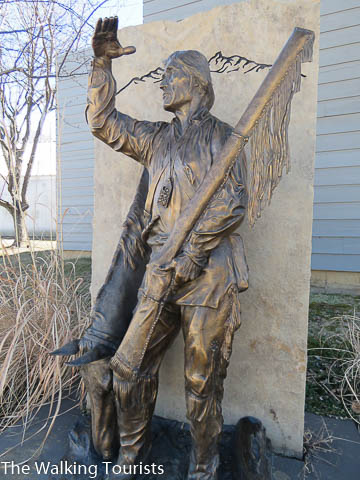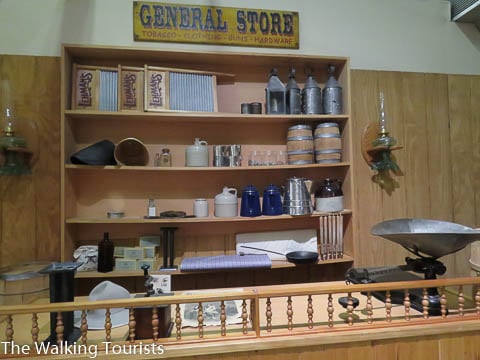Independence museum follows pioneer trails

“Wagons Ho!” can be heard in almost any early western movie about pioneers heading west for a new life in 1800s America. The trail boss would wave his hat in the air and yell out the words and then wagons would start moving along in a straight line, with men, women and children in them and walking behind them.
There may have been a little truth to the movie scenes, but the westward expansion was a lot tougher than what was portrayed on the big screen. Pioneers struggled as they made their way across strange land, encountering rough terrain, swollen rivers, rattlesnakes and native opposition to their moves.
The National Frontier Trails Museum in Independence (MO) examines life as a pioneer among three major trails that ran through the area – California, Oregon and Santa Fe. A fourth – the Mormon Trail – almost followed the same route as the Oregon Trail. Both trails crossed through Nebraska, so we’ve actually been lucky to see old wagon wheel ruts in western Nebraska.
Independence, St. Joseph and Weston were Missouri towns that served as starting points for trails. Council Bluffs, Iowa, served as a resting point and trading post for the Mormon Trail.

The Santa Fe Trail was the least known to me prior to my museum visit. Independence served as the primary eastern “terminus” – starting point – for the trail. People would get supplies and whatever else they may need from the local merchants, blacksmiths and other shop keepers.
The museum tracked the 1,200-mile route from Old Franklin (MO) to Santa Fe, which had a strong Mexican influence. During one stretch of the route, travelers encountered rattlesnakes. One soldier was allegedly bitten on a finger. The Army surgeon gave him whiskey to “liquor him up,” so he felt no pain while the doctor cut, burned and treated the wound. When other soldiers caught wind of the whiskey aspect of the operation, several claimed to have been bitten. The surgeon, once he caught on, told them he would treat the wound first and then supply the whiskey. Men suddenly started feeling better.

Nights around the fire brought out conversation in both English and Spanish. Music was enjoyed by the pioneers. The museum recognizes the variety of music, languages and religions practiced along the way.

The Santa Fe Trail took about three months to complete from Independence. The Santa Fe Trail existed from 1821 until 1880.

The second trail featured at the museum – the Oregon Trail – started in St. Charles (MO), with a “jumping off” point in Independence. The route took westward travelers 2,200 miles to their new homes in the Oregon valleys. The route cut through northeast Kansas through much of Nebraska, Wyoming, Idaho and ending in Oregon.

Travelers brought personal items they believed would be needed in their new homes and were of sentimental value. But, as the groups trudged on through the “Great American Desert” – the name given to the plains, as they were deemed uninhabitable. Pioneers had to deal wide rivers and the Rocky Mountains.
People would toss aside a lot of the items they brought with them, keeping the bare necessities. The abandoned items became known as “Trail Trash.”

It was common to see thousands of American bison thunder past the caravans. The Oregon Trail saw its largest influx of emigrants during the 1843 migration, when up to 1,000 people traveled along the route.
The Mormon Trail, which started in Nauvoo, Illinois, and eventually connected along a partial route of the Oregon Trail, is highlighted at the museum. The members of the Church of Jesus Christ of Latter-Day Saints didn’t want to leave Illinois, but did so to avoid religious persecution.
Members of the Mormon Trail spent winters in the Omaha-Council Bluffs area, renaming Council Bluffs Kanesville. Once the Mormons had moved on, locals went back to using the name Council Bluffs.
One group of people may be best known for the final trail highlighted at the museum – the California Trail, which eventually ended in Sacramento. One travel party didn’t make it intact. The Donner Party – yep, them – departed Springfield, Illinois, in April 1846.
The party followed the standard route for the California Trail, which paralleled the Oregon Trail for part of the trip. In Wyoming, they decided to detour from the trail and head for a southern route. They believed it would get them to California sooner.
They lost 18 travels days during part of the trip in Utah. Then, they encountered an early season snowstorm that blocked them from moving forward. Half of the 90-person group were supposedly cannibalized by the others in order to survive. The phrase “Donner Party” is usually recognized right away.

The California Trail did more than create the Donners. More than 200,000 people – including men seeking their wealth in gold – used the trail over a nine-year period. Early on, it took almost half a year to travel the 2,000-mile stretch. Later, it averaged less than four months.
One gold seeker abandoned his search to return home. He walked about 2,300 miles. Along the way, he found a discarded rocking chair. He carried it with him…as a gift for his wife.

In the 1860s, overland trails suffered a hit as the Union Pacific and other railroad companies came to life. The creation of the transcontinental railroad eliminated the need for the mass migration via the trails.

The museum also takes a look at the initial American westward expansion, with the Lewis and Clark expedition in the early 1800s. The duo led a team of about 50 men from the St. Louis area up the Missouri River to the mouth of the Columbia River between Washington and Oregon.

The National Frontier Trails Museum is an interesting spot to visit in the Kansas City Metro area. Independence is the hometown of President Harry Truman and offers a look at the president’s life and attractions related to it. Combining the museum with Truman activities would be a fun way to spend a day. Otherwise, the museum, itself, can take at least an hour to tour.
I recommend visiting the trails museum. It’s interesting and informative. There is a $6 admission fee for adults. Children under 17 can get in for $3. It’s opened daily (except for some holidays).
For more information, please visit http://www.ci.independence.mo.us/NFTM or www.visitkansascity.com.




